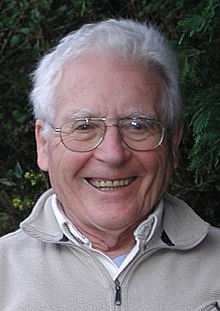James Lovelock | |
|---|---|
 Lovelock in 2005 | |
| Born | James Ephraim Lovelock 26 July 1919 Letchworth, Hertfordshire, England |
| Died | 26 July 2022 (aged 103) Abbotsbury, Dorset, England |
| Alma mater | |
| Known for | |
| Spouses | Helen Hyslop
(m. 1942; died 1989)Sandy Orchard (m. 1991) |
| Children | 4 |
| Awards | See list |
| Scientific career | |
| Fields | |
| Institutions | |
| Thesis | The properties and use of aliphatic and hydroxy carboxylic acids in aerial disinfection (1947) |
| Website | Official website |
James Ephraim Lovelock CH CBE FRS (26 July 1919 – 26 July 2022) was an English independent scientist, environmentalist and futurist. He is best known for proposing the Gaia hypothesis, which postulates that the Earth functions as a self-regulating system.
With a PhD in the chemistry of disinfection, Lovelock began his career performing cryopreservation experiments on rodents, including successfully thawing frozen specimens. His methods were influential in the theories of cryonics (the cryopreservation of humans). He invented the electron capture detector and, using it, became the first to detect the widespread presence of chlorofluorocarbons in the atmosphere. While designing scientific instruments for NASA, he developed the Gaia hypothesis.
In the 2000s, he proposed a method of climate engineering to restore carbon dioxide–consuming algae. He was an outspoken member of Environmentalists for Nuclear Energy, asserting that fossil fuel interests have been behind opposition to nuclear energy, citing the effects of carbon dioxide as being harmful to the environment and warning of global warming due to the greenhouse effect. He wrote several environmental science books based upon the Gaia hypothesis from the late 1970s.
He also worked for MI5, the British security service, for decades.[1] Bryan Appleyard, writing in The Sunday Times, described him as "basically Q in the James Bond films".[2]
- ^ Clarke B, Dutreuil S, eds. (18 August 2022). Writing Gaia: The Scientific Correspondence of James Lovelock and Lynn Margulis. Cambridge University Press. ISBN 978-1-108-96794-5.
- ^ Appleyard B (21 August 2022). "Writing Gaia review: what my friend James Lovelock's letters reveal". The Sunday Times. Archived from the original on 23 August 2022. Retrieved 22 August 2022.